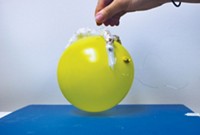Advertisement
Grab your lab coat. Let's get started
Welcome!
Welcome!
Create an account below to get 6 C&EN articles per month, receive newsletters and more - all free.
It seems this is your first time logging in online. Please enter the following information to continue.
As an ACS member you automatically get access to this site. All we need is few more details to create your reading experience.
Not you? Sign in with a different account.
Not you? Sign in with a different account.
ERROR 1
ERROR 1
ERROR 2
ERROR 2
ERROR 2
ERROR 2
ERROR 2
Password and Confirm password must match.
If you have an ACS member number, please enter it here so we can link this account to your membership. (optional)
ERROR 2
ACS values your privacy. By submitting your information, you are gaining access to C&EN and subscribing to our weekly newsletter. We use the information you provide to make your reading experience better, and we will never sell your data to third party members.
Education
Newscripts
The art of protein synthesis, Explosive education, Fruit ripeness sticker
August 14, 2006
| A version of this story appeared in
Volume 84, Issue 33
The art of protein synthesis
A little educational gem recently made the rounds among weblogs such as Improbable Research and Boing Boing. "Protein Synthesis: An Epic on the Cellular Level" was filmed in 1971 at Stanford University as an educational resource for describing the process of synthesis by a ribosome.
In true '70s style, however, dancers and students perform the roles of the ribosome, messenger RNA, and activators. A female narrator describes the steps using Jabberwocky-esque rhyme, while the process is set to some groovy live music. The dance is introduced by chemistry Nobel Laureate Paul Berg. The straight-faced Berg explains that "this film attempts to portray symbolically, yet in a dynamic and joyful way, one of nature's fundamental processes—the linking together of amino acids to form a protein."
Some blog visitors have commented that the film is still shown in biology classes. Kenyon College biology professor Joan L. Slonczewski confirmed that the film has aged well as a practical teaching tool. The film "remains a surprisingly accurate depiction of ribosome function, particularly useful for conveying the concept of random motion of disordered components such as an unfolded protein," she says.
Slonczweski not only provides a link to the out-of-print film on her website, but she also assisted with a re-creation of the film's dance performed at the dedication of Kenyon's new athletic center in April. The project demonstrated "the synthesis of the arts, science, and physical activity," Slonczewski tells C&EN. She explains that protein synthesis "relates directly to athletic activity, which involves high protein turnover in muscles and the nervous system."
About 100 students, faculty, and family members participated in the Kenyon project. MIT biochemist and Kenyon alumnus Harvey F. Lodish assumed Berg's introductory role. The original film's director, Gabriel Weiss, and choreographer, Jackie Benington Weiss, also attended the performance.
The original film can be viewed at biology.kenyon.edu/courses/biol114/proteindance.
Explosive education
An item about a high school student's attempt to make TNT (C&EN, July 17, page 104) reminded reader John Hinshaw in Hillsboro, Ore., of his days as a teaching assistant in 1977, "back when the nitration of benzene was a standard experiment."
Two ambitious premed students thought concocting a high yield of nitrobenzene would look impressive to medical school acceptance committees. During their experiment, the dynamic duo added more nitration reagent than the less-than-stoichiometric amount called for while at the same time increasing the voltage to the heating mantle. "Soon the liquid in the reaction flask began to take on a dark orange-red color as significant amounts of dinitrobenzene began to accumulate," says Hinshaw, who was able to intervene just in the nick of time. He evacuated the lab and pulled down the hood door moments before the flask detonated, "leaving little behind but the ground glass joints."
Even though he escaped physical harm, clearly the incident left Hinshaw with emotional scars. "I still have an occasional nightmare in which I'm in the emergency room with those two in attendance!"
Fruit ripeness sticker
Everyone knows you can't judge a fruit by its cover. But you may soon be able to judge a fruit's ripeness by its sticker. Ken Sweet reported in the Arizona Daily Star last month that University of Arizona professor Mark Riley has developed a sticker that can indicate when a fruit or vegetable has reached optimal munchability.
Riley's RediRipe sticker detects ethylene gas, which is released by fruits and veggies as they ripen. Increasing levels of ethylene cause the sticker to change from white to increasingly deeper shades of blue over a period of 24 to 48 hours.
RediRipe won't be the final solution to ripeness guesswork, however. The sticker cannot detect overripe or rotten fruit, and not all produce emits enough ethylene for the sticker to detect. According to Sweet's article, the sticker will be cheap (about a penny) and could be in stores in two or three years.
This week's column was written by Rachel Pepling. Please send comments and suggestions to newscripts@acs.org.





Join the conversation
Contact the reporter
Submit a Letter to the Editor for publication
Engage with us on Twitter